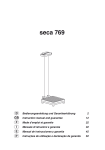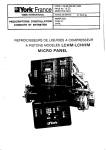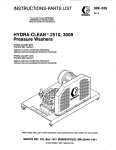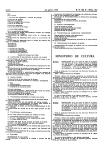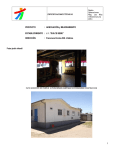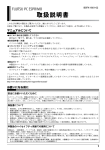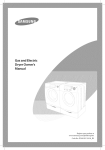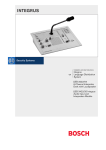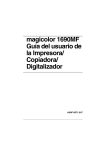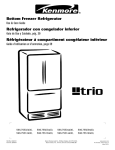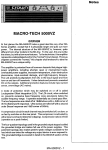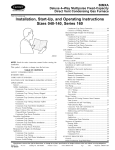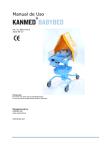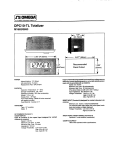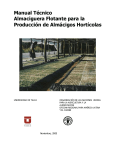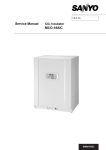Download CuproBraze - Repositorio
Transcript
~
: ~AK~ .
••
••
••
••
•••
••
••
••
••
••
••
••
••
••
••
••
•••
••
••
••
••
••
••
••
••
FONTEC - CORFO
CODIGO
199-2024
TITULO
FABRICACIÓN DE RADIADORES CON NUEVA
TECNOLOGÍA CUPROBRAZE
EMPRESA
GESTORA
RADIADORES GALLARDO LAPAPORTE S.A.
FECHA
Octubre 2001
629.23
R 129
2001
1
-'
PRESENTACIÓN
••
i
i
En el último decenio, se constata que el país ha sabido ~nir~rmr ,,, 11
éxito el desafío impuesto por la política de apertura en k's mer.:ados
internacionales, alcanzando un crecimiento y desarrollo económico
sustentable, con un sector empresarial dinámico. innovador ,. capaz de
adaptarse rápidamente a las señales del mercado.
Sin embargo, nuestra estrategia de desarrollo, fundada en el mayor
esfuerzo exportador y en un esquema que principalmente hace uso de las
ventajas comparativas que dan los recursos naturales y la abundancia relativa
de la mano de obra, tenderá a agotarse rápidamente como consecuencia del
propio progreso nacional. Por consiguiente, resulta determinante afrontar una
segunda fase exportadora que debe estar caracterizada por la incorporación de
un mayor valor agregado de inteligencia, conocimientos y tecnologías a
nuestros productos, a fin de hacerlos más competitivos.
Para abordar el proceso de modernización y reconverswn de la
estructura productiva del país, reviste vital importancia el papel que cumplen
las innovaciones tecnológicas, toda vez que ellas confieren sustentación real a
la competitividad de nuestra oferta exportable. Para ello. el Gobierno ofrece
instrumentos finam;ieros que promueven e incentivan la innovación y el
desarrollo tecnológico de las empresas productoras de bienes y servicios.
El Fondo Nacional de Desarrollo Tecnológico y Productivo FONTEC,
organismo creado por CORFO, cuenta con los recursos necesarios para
financiar Proyectos de Innovación Tecnológica, formulados por las empresas
· del sector privado nacional para la introducción o adaptación y desarrollo de
productos, procesos o de equipos.
Las Líneas de financiamiento de este Fondo incluyen, además, el apoyo
a la ejecución de proyectos de Inversión en Infraestructura Tecnológica y de
Centros de Transferencia Tecnológica a objeto que las empresas dispongan de
sus propias instalaciones de control de calidad y de investigación y desarrollo
de nuevos productos o procesos.
De este modo se tiende a la incorporación del concepto "Empresa País", en la comunidad nacional, donde no es sólo una empresa aislada la que
compite con productos de calidad, sino que es la "Marca - País" la que se hace
presente en los mercados internacionales.
El Proyecto que se presenta, constituye un valioso aporte al
cumplimiento de los objetivos y metas anteriormente comentados.
FONTEC - CORFO
•
,
•••••••••••••••••••••••••••••••••••••••••••••••••••••••
•
•
•
A) Resumen Ejecutivo
• Antecedentes de la Empresa
• Síntesis del proyecto de Innovación
• Principales Resultados del Proyecto y
Conclusiones
•
•
•
•
•
•
•
•
••
••
••
••
••
••
••
•••
••
••
•••
••
•••
•••
••
••
••
••
••
••
••
•••
••
••
•
a) Resumen Ejecutivo
Antecedentes de la Empresa
Radiadores Gallardo Laporte S.A., Rut. 96.803.940 - 7 fue constituida en
Santiago de Chile el 17 de Diciembre de 1996 ante el notario publico Doña
Mercedes Moreno Guemes, titular de la Primera Notaría de Santiago, anotada en
el repertorio N• 174.641 e inscrita a fs. 33100 N° 25.869 del año 1996 .
La empresa tiene como giro el Diseño, Fabricación y Servicio ( Reparación y
Mantención ) de Radiadores e lntercambiadores de Calor.
Radiadores
• Panales Automotrices e Industriales
• Radiadores de Automotrices e Industriales
• Radiadores de Tubos Intercambiables
lntercambiadores de Calor
• Haz Tubular/Carcaza
• Enfriadores de Aceite/Aire
• Sistema de Tubos Aleteados
Síntesis del proyecto de Innovación
-
~·
----~-
..
~-IBLIOTECA CORFO J
·-_..c
Cuprobraze, es una tecnología desarrollada por Outokumpu e ICA ( Asoc .
Internacional de Cobre) , para competir con los Radiadores Aluminio 1 Plástico que
han reemplazando el uso de Cu en el mercado OEM ( Original Equipment
Manufacture) y gran parte del Mercado de Reposición ( Aftermarket ).
Outokumpu ofrece a Radiadores Gallardo Laporte S.A. la Transferencia de esta
nueva Tecnología .
Esta tecnología Mejora las prestaciones de servicio y AMBIENTALES en relación
al los Radiadores de Cu tradicional y los de Al. Los Radiadores de Cobre son más
resistentes a la corrosión, impacto y vibraciones que los de Al.
Esta tecnología disminuye costos de Producción .
En Chile se importan USD 3.000.000.- al año en Radiadores, principalmente de
Aluminio 1 Plástico, lo que implica un gran potencial de sustitución de
importaciones y luego de exportación .
Tecnología Cuprobraze se desarrollo pensando en el Medio Ambiente .
Es una aleación autofundente, por lo que no utiliza fundente, plomo, ni otro mineral
contaminante. La Aleación de Cobre no posee Cadmio .
••
••
•
••
•••
••
•••
••
••
••
•••
•••
••
••
••
••
••
••
•••
••
••
••
••
••
••
•
El Ciclo completo de los Radiadores Cuprobraze es significativamente más
ecológico que el de Aluminio, desde la extracción de la materia prima hasta el
reciclado de los radiadores fuera de uso .
El objetivo de esta tecnología es recuperar y sustituir el uso del aluminio en la
fabricación de Radiadores .
Se busca el estudio e implementación de un proceso piloto que permita la
adaptación de la tecnología para fabricar Radiadores CUPROBRAZE, a una
escala adaptada a la realidad nacional.
Evaluar e investigar el uso de esta tecnología
intercambiadores de calor industriales e lntercoolers .
en
la
fabricación
de
Principales Resultados del Proyecto y Conclusiones
Se produce la Transferencia Tecnológica de Outokumpu a Radiadores Gallardo
Laporte S.A.
La tecnología Cuprobraze presenta un gran potencial y cuenta con el respaldo de
Outokumpu y otros productores mundiales de Cobre. Ademas de ICA. El objetivo
final es recuperar terreno perdido con el Aluminio .
La tecnología Cuprobraze esta en su etapa de introducción y varios fabricantes en
el mundo están en su etapa experimental y estudiando la implementación en otras
aplicaciones a los radiadores de agua como lntercooler y enfriadores de Aceite .
Se fabrica maquinaria para proceso y construcción de prototipo ..
Se fabrica prototipo de Panal Automotriz con tecnología Cuprobraze, con resultado
positivo .
Se investiga en productos como enfriadores de aceite e intercoolers .
Radiadores Gallardo Laporte S.A. fabrica un prototipo de Enfriador de Aceite 1 Aire
para ser desarrollado con tecnología Cuprobraze .
Se fabricará un prototipo que se ha estado desarrollando para fabricar Charge Air
Cooler en Cobre o intercooler, el que será evaluado por Outokumpu .
Se establece relación de trabajo de largo plazo con Outokumpu para el desarrollo
de esta tecnología y se tiene acceso a uso del centro Técnico de Outokumpu. Esto
implica trasferencia tecnológica permanente, asistencia técnica, acceso a sus
laboratorios, uso de maquinaria para construcción de prototipos y uso de tunel de
viento para evaluación de productos .
••••••••••••••••••••••••••••••••••••••••••••••••••••••••
•
•
•
B) Exposición del Problema
• Antecedentes Técnicos del Proyecto
• Objetivos Técnicos y Resultados
Perseguidos
• Tipo de Innovación Desarrollada
•
•
•
•
•
•
•
•
•••••••••••••••••••••••••••••••••••••••••••••••••••••••
•
•
•
Antecedentes Técnicos del Proyecto
• Tecnología desarrollada por Outokumpu e ICA (
Asoc. Internacional de Cobre) , para competir con los
Radiadores Aluminio 1 Plástico que están
reemplazando el uso de Cu en esta Aplicación.
• Outokumpu ofrece a Radiadores Gallardo Laporte
S.A. La Transferecia de esta nueva Tecnología
Llamada Cuprobraze.
• Tecnología Mejora Prestaciones de Servicio y
AMBIENTALES en relación al los Radiadores de Cu
tradicional y los de Al.
•
•
•
•
•
•
•
•
••••••••••••••••••••••••••••••••••••••••••••••••••••••••
•
•
•
Antecedentes Técnicos del Proyecto
• El Cobre es la principal actividad económica de
Chile.
• Esta tecnología disminuye costos de Producción.
• Los Radiadores de Cobre son más resistentes a la
corrosión, impacto y vibraciones que los de Al.
• En Chile se importan USO 3.000.000.- al año en
Radiadores, principalmente de Aluminio 1 Plástico, lo
que implica un gran potencial de sustitución de
importaciones y luego de exportación .
•
•
•
•
•
•
•
•
••••••••••••••••••••••••••••••••••••••••••••••••••••••••
•
•
•
Antecedentes Técnicos del Proyecto
• Tecnología Cuprobraze se desarrollo pensando en el
Medio Ambiente.
• Es una aleación autofundente, por lo que no utiliza
fundente, plomo, ni otro mineral contaminante. La
Aleación de Cobre no posee Cadmio.
• El Ciclo completo de los Radiadores Cuprobraze es
significativamente más ecológico que el de Aluminio,
desde la extracción de la materia prima hasta el
reciclado de los radiadores fuera de uso .
•
•
•
•
•
•
•
•
••••••••••••••••••••••••••••••••••••••••••••••••••••••••
•
•
•
Objetivos del proyecto
• Estudio e implementación de un
proceso piloto que permita la
adaptación de la tecnología para
fabricar Radiadores CUPROBRAZE, a
una escala adaptada a la realidad
nacional .
.
~--
ce
~}
6¡1
ñ=l.
~/
-
;;
~- ,,
O¡
~:~·
. -=--=-- '.
•
•
•
•
•
•
•
~·······················································
•
•
•
Objetivos del proyecto
• Evaluar e investigar la aplicación de la
tecnología CUPROBRAZE, en la
fabricación de lntercambiadores de
Calor e lntercoolers.
•
•
•
•
•
•
•
•
~·······················································
•
•
•
Tipo de Innovación Desarrollada
• Transferencia de Tecnología Cuprobraze y
adaptación de ésta a escala de producción y
realidad Chilena.
• Nuevo Proceso para la Fabricación de
Radiadores Automotrices.
• Desarrollo de Prototipos para la Fabricación
de Enfriadores de Aceite Industriales en
Cobre y con Tecnología Cuprobraze.
•
•
•
•
•
•
•
•
••••••••••••••••••••••••••••••••••••••••••••••••••••••••
•
•
•
C) Metodología y Plan de Trabajo
• Recopilación de Antecedentes y
Literatura entregada por Outokumpu.
• Visita a Outokumpu Suecia, Ingeniero
Rafael Gallardo, para transferencia
tecnológica.
• Fabricación de Máquinas y procesos
prototipos.
•
•
•
•
•
•
•
•
••••••••••••••••••••••••••••••••••••••••••••••••••••••••
•
•
•
C) Metodología y Plan de Trabajo
• Implementación de Procesos Piloto,
Pruebas y Ensayo.
• Visita a Outokumpu Suecia, Rodrigo
Gallardo, Jefe del Proyecto y Gerente
General de Radiadores Gallardo
Laporte S.A.
•
•
•
•
•
•
•
•
t••·····················································
•
•
•
C) Metodología y Plan de Trabajo
• Fabricación Prototipo Panal
Automotriz.
• Fabricación Prototipo Enfriador de
Aceite, Pruebas a 100 psi sostenidos de
Presión.
• Pruebas y Evaluación de Prototipos.
•
•
•
•
•
•
•
•
••••••••••••••••••••••••••••••••••••••••••••••••••••••••
•
•
•
D) Resultados Obtenidos
• Transferencia Tecnológica
• Visita Ingeniero Rafael Gallardo Laporte
a Centro Técnico y Planta Piloto
Cuprobraze en Outokumpu, Suecia.
• Septiembre, Año 2000.
•
•
•
•
•
•
•
•
••
••
••
••
••
•••
••
••
•••
•••
••
••
••
•••
•••
•••
••
•••
••
••
••
••
••
••
•
Q)
t:
•
ª"o
•
~
.........
.........
•
tJ
•
o
~
•
<(
•
(/)
"'d
C\1
.........
Q)
C)
0::
1
:::J
0..
E
~
C\1
•
;j
•
S
]
•
~
p.,
o
"S
o
:::J
~
o
+-'
:::J
o
Q)
N
C\1
~
__r:¡
o
~
u
o
p.,
._.
~
;j
• • •
O"'
~
••••••••••••••••••••••••••••••••••••••••••••••••••••••••
•
•
•
Máquina Tubera
Máquina que
fabrica los tubos de
Radiador.
El Radiador
Cuprobraze
funciona con tubos
sin costura.
Se están haciendo
pruebas con tubos
emballetados para
fábricas de menor
escala de
Outokumpu- Suecia, Lab. Proyecto Cuprobraze
producción
•
•
•
•
•
•
•
•
~·······················································
•
•
•
Secado de Tubos con Pasta
Se empasta tubo a
tubo en forma
manual y luego se
ponen los tubos en
esta bandeja
transportadora
para su secado.
Outokumpu - Suecia
Laboratorio Proyecto
Cuprobraze
•
•
•
•
•
•
•
•
••••••••••••••••••••••••••••••••••••••••••••••••••••••••
•
•
•
Secado de Tubos con Pasta
Proceso
Experimental de
Secado de Tubos
con Pasta de
Brazado.
Outokumpu - Suecia
Laboratorio Proyecto
Cuprobraze
•
•
•
•
•
•
•
•
••••••••••••••••••••••••••••••••••••••••••••••••••••••••
•
•
•
Máquina de Rodillo
Máquina de Rodillo
para la fabricación
de aletas o rizos de
Radiadores.
Outokumpu - Suecia
Laboratorio Proyecto
Cuprobraze
•
•
•
•
•
•
•
•
••••••••••••••••••••••••••••••••••••••••••••••••••••••••
•
•
•
Rodillos para Máq. Aletas
Múltiples set de
Rodillos para
fabricar distintos
tipos de
Radiadores.
Outokumpu- Suecia
Laboratorio Proyecto
Cuprobraze
•
•
•
•
•
•
•
•
••••••••••••••••••••••••••••••••••••••••••••••••••••••••
•
•
•
Aplicación de Pasta a Rizo
Experimentando
formas de aplicar
pasta de brazado a
Rizo.
Se aprecia en la
foto, forma de
aplicar manual y
distinta a la del
Manual Técnico
Cuprobraze, Feb.
2000.
Outokumpu- Suecia
Laboratorio Proyecto
Cuprobraze
•
•
•
•
•
•
•
•
••••••••••••••••••••••••••••••••••••••••••••••••••••••••
•
•
•
Aplicación Pasta a Rizos
Rodillo con Pasta
Sacar exceso
de Pasta
Rizos después de
poner pasta
Outokumpu - Suecia
Laboratorio Proyecto Cuprobraze
•
•
Pruebas de Aplicación de Pasta
de Brazado a Rizo
•
•
•
•
•
•
~·······················································
•
•
•
Mesa de Armado Panal
Mesa de Armado
Panal, antes de
tratamiento térmico
(Horno)
Outokumpu - Suecia
Laboratorio Proyecto
Cuprobraze
•
•
•
•
•
•
•
•
••••••••••••••••••••••••••••••••••••••••••••••••••••••••
•
•
•
Fabricación de Colectores
Punzonadora de
Control numérico
para fabricar
colectores.
Outokumpu - Suecia
Laboratorio Proyecto
Cuprobraze
•
•
•
•
•
•
•
•
••••••••••••••••••••••••••••••••••••••••••••••••••••••••
•
•
•
Entrada del Horno
Se abre el carro
para insertar Panal
de Radiador
Cuprobraze en el
Horno
Outokumpu- Suecia
Laboratorio Proyecto
Cuprobraze
•
•
•
•
•
•
•
•
••••••••••••••••••••••••••••••••••••••••••••••••••••••••
•
•
•
Precalentador Panal
Precalentador
Panal antes de
entrar al horno.
Se estaba
probando en varias
etapas para tomar
los 600° C.
Outokumpu - Suecia
Laboratorio Proyecto
Cuprobraze
••••••••••••••••••••••••••••••••••••••••••••••••••••••••
•
•
•
Estanque de Nitrógeno
Estanque con
Nitrógeno para
inyectar al Horno
de atmósfera
controlada.
Outokumpu - Suecia
Laboratorio Proyecto
Cuprobraze
•
•
•
•
•
•
•
•
~·······················································
•
•
•
Etapa Inyección Nitrógeno
Etapa en que se
inyecta nitrógeno
al horno.
Outokumpu- Suecia
Laboratorio Proyecto
Cuprobraze
•
•
•
•
•
•
•
•
•••••••••••••••••••••••••••••••••••••••••••••••••••••••
•
•
•
Probando Radiador Industrial
Se están probando
Radiadores
Cuprobraze para
Camiones con
estanques
apernados.
Todavía hay
problemas de
filtración en la
unión colectortubos
Outokumpu- Suecia, Laboratorio Proyecto Cuprobraze
•
•
•
•
•
•
•
•
••
••
••
••
••
••
••
••
••
••
••
••
••
••
••
••
••
••
••
••
•••
••
••
••
••
••
•
•
•
<(
•
(j)
C/)
-ro
Q)
Q)
t
o
Cl..
ro
_J
o
"E
ro
-
ro
ro
o.
(j)
ro
•
-
(j)
Q)
S...
.¡...1
o
Q)
-<(
üQ)
Q)
"O
ro
o
-c ro
ro·-·
O..,b
S...
.¡...1
w
:::J
"O
w e
UJs...
ro o
C-c
·ro
:::J · . 0"'-c
ro ro
-o
o
S...
ro
o.
E
ro
.¡...1
(j)
UJ
ro
ro
o.
S...
N
•
•
o
"O
ro
•
•
•
.¡...1
Q)
-ro
•
E
•
..e
Q)
(j)
o
..e
:::J
1-
ro
ro
o.
ro
S...
S...
Q)
..e
:::J
1-
~~
• ••
•
S...
E
ro
·-
•
•
•••••••••••••••••••••••••••••••••••••••••••••••••••••••
•
•
•
Máquina Aletadora
Máquina
Estampadora de
Aletas para
Radiador Industrial
( 100 °/o )
Radiadores Gallardo Laporte S .A. - Proyecto Cupro braze
•
•
•
•
•
•
•
•
•••••••••••••••••••••••••••••••••••••••••••••••••••••••
•
•
•
Matriz Colectores Industriales
Matriz para estampar
colectores
industriales.
80 o/o estado de
avance.
En planta piloto
Outokumpu utilizaban
una punzonadora
automática y
programable
Radiadores Gallardo Laporte S .A. - Proyecto Cupro braze
•
•
•
•
•
•
•
•
••
••
••
••
••
•••
••
••
••
••
••
••
••
•••
••
••
••
••
••
••
••
••
••
••
••
••
•
•
Q)
N
ro
¡.....¡
..D
•
o
¡.....¡
en
o
.e
::J
1-(])
-e
ro
e
·::J
o-
-.ro
~
§"
u
o
..¡....>
u
•
Q)
~
o
¡.....¡
•
•
•
p..¡
<
r./1
•
Q)
t:
o
ª"
~
o
'"d
~
ro
d
00
Q)
¡.....¡
o
'"d
·-""'
ro
ro
~
• • •
•
•
••
••
••
••
••
••
••
••
••
••
••
••
••
•••
•••
••
••
••
••
••
•••
•••
••
••
••
...
•
•
O)
N
clj
$.-;
,D
•
o
$.-;
en
o
.e
:::J
§"
u
o
.......
u
O)
$.-;
~
(])
<
r./l
•
O)
to
·:::J
H
e-
--ro
~
ª"
o
"'-a'
-d
clj
VJ
O)
$.-;
o
clj
."'"""
"''
"'~'
• • •
•
•
•
ro
e
•
~
o
1--
-e
•
•
••
••
••
••
••
••
••
••
••
•••
••
••
••
••
••
••
•••
•••
••
••
••
••
••
••
••
•
•
•
Cl)
N
ro
;....;
"8;....;
en
o
..e
:J
t())
'"O
ro
e
·:J
o-
--ro
~
§"
•
o
.......
•
u
u
Cl)
~
o;....;
•
A.,
•
<
r:/J
•
•
Cl)
t::
o
ª"
~
o
]
,........¡
,........¡
ro
d
m
Cl)
;....;
o
."'ro""
""'
""'~ro
• ••
•
•
•••••••••••••••••••••••••••••••••••••••••••••••••••••••
•
•
•
Tubos emballetados
Tubos
emballetados.
Radiadores Gallardo Laporte S.A.- Proyecto Cuprobraze
•
•
•
•
•
•
•
•
•••••••••••••••••••••••••••••••••••••••••••••••••••••••
•
•
•
Transferencia Tecnológica
• Visita Rodrigo Gallardo Díaz, a Centro
Técnico y Planta Piloto Cuprobraze en
Outokumpu, Suecia.
• Vaasteras, Finspong.
• Junio, Año 2001.
•
•
•
•
•
•
•
•
•••
•••
••
•••
•••
••
••
•••
•••
•••
•••
•••
•••
•••
•••
•••
••
•••
•••
••-
•
•
•
Q)
•
·-o
CG
::l
en
tn"'
CG
'Q)
....tn
CG
CG
>
o"'
o
·-eo
~Q)
1-
o
....e'Q)
(.)
1
::l
c.
E
::l
~
....::lo
o
• • •
•
Q)
N
ca
l..
.Q
•
ol..
Q,
:::J
(.)
o
·-....oc.
....o
l..
a..
l..
o
"C
ca
·-"Cca
a:
•
•
•
••
••
•••
••
••
••
••
••
••
••
••
••
••
•••
••
••
••
••
••
••
••
••
••
••
••
••
•
•
•
( .)
Cl)
•
cu
·:S
en
•
•
•
o(.)"'
·-e
(.)
•CI)
l-
e
.....,
e
Cl)
o
1
:S
c.
E
:S
~
o
.....,
:S
o
• ••
•
•
••
••
••
••
••
•••
••
••
•••
••
••
••
••
•••
•••
••
••
••
••
••
••
•••
••
••
•
•
•
•
(J
Cl)
•
ca
·:S
U)
•
•
•
...
o(J
•
·-r::::
(J
•
~CI)
l-
o
....
+'
r::::
Cl)
o
1
:S
o.
E
:S
~
o
:S
ro
l...
+'
o
• • •
~
ro
a..!:
cn
cci
l...
Q) en ::J
.o O....,
::J .o en
::Jo
1- ...... (.)
~·······················································
•
•
•
Outokumpu - Centro Técnico, Vaasteras, Suecia.
Panal Prototipo para fabricación
de Charge Air Coolers, enfriadores
de Aire de Los Turbas, en Cobre
con Tecnología Cuprobraze.
Actualmente el panal es fabricado
en Aluminio con tecnología
Nocolok y Aluminio Brazado y
Ambos Estanques en Alumino
Fundido.
Los CAC conocidos como
lntercooler son utilizados en
Camiones y Buses principalmente .
•
•
•
•
•
•
•
•
•••••••••••••••••••••••••••••••••••••••••••••••••••••••
•
•
•
Outokumpu - Centro Técnico, Vaasteras, Suecia.
El tubo es armado a partir de dos
Len plancha de 0,8 mm de
espesor.
En su interior se inserta un Rizo
para retención del Aire, caída de
presión necesaria y mayor área de
transferencia en contacto con el
a1re.
Escuadras en Planchas de 1 ,O
mm de espesor.
•
•
•
•
•
•
•
•
••••••••••••••••••••••••••••••••••••••••••••••••••••••••
•
•
•
Outokumpu - Finspang, Suecia.
• La Tecnología CuproBraze está en una etapa
Experimental avanzada y de Introducción a
varios fabricantes del Mundo.
• Tanto Outokumpu como varios fabricantes
están experimentando y desarrollando
prototipos para aplicaciones Industriales
como enfriadores de aceite e intercoolers.
~-
.....
'
' co
ffi'
r-
a
ñ=l
~
¡;;g
C')
§i
•
t.
--~-
1
•
•
•
•
•
•
t••·····················································
•
•
•
Outokumpu - Finspang, Suecia.
• En Radiadores hay dos mercados : a) OEM y
b) Aftermarket.
• Inicialmente se quería el uso de esta
tecnología en OEM, Original equipment
manufacture ( Fabricantes de Automoviles )
• Este mercado es dominado por pocas
empresas en el mundo, las que no quisieron
adoptar inicialmente la tecnología
Cuprobraze.
•
•
•
•
•
•
•
•
••••••••••••••••••••••••••••••••••••••••••••••••••••••••
•
•
•
Outokumpu - Finspang, Suecia.
• Al Orientarse al mercado Aftermarket (
Mercado de Reposición ), fábricas como las
nuestras pueden entrar en el proyecto.
• En esta etapa los fabricante OEM están ·
experimentando con la tecnología y en etapa
de desarrollo de futuros modelos para
automóviles nuevos.
•
•
•
•
•
•
•
•
t••·····················································
•
•
•
Outokumpu - Finspang, Suecia.
• La tecnología fue concebida pensando para
la fabricación de Radiadores.
• Pero con el tiempo se ha manifestado un alto
interés de parte de los fabricantes en el usos
de esta tecnología en lntercooler y
Enfriadores de Aceite industriales.
•
•
•
•
•
•
•
•
••
••
••
••
•••
••
••
••
•••
••
••
••
••
••
••
••
••
•••
•••
••
••
••
••
••
••
•
•
<(
•
•
C/)
•
(].)
-ro
•
t
o
a.
ro
_J
o
-e
'ro
-ro
S....
-foJ
(/)
:J
e
-
•
N
·Q)
•
S....
(.)
o
<(
Q)
-foJ
·-foJ
E
"'C
:J
S....
en
-ro
o
-e
ro
·-e
ro
a:
(])
o
C)
'-
•
"'C
-foJ
(].)
• • •
·-
•
<(
e
ro
a..
o
"'C
ro
·'+S....
e
w
o
o
·-foJ
·-
-foJ
-foJ
a..
a..
•
•
c.
o
o
S....
c.
-foJ
o
o
S....
•
••
••
••
••
••
••
•••
••
••
••
••
••
••
••
••
••
••
••
••
•••
••
••
••
••
••
••
•
•
•
il)
N
ro
.n
o
1-<
N
·S....
+-'
o
E
o
+-'
:::J
<(
-co
e
co
a..
o
c..
·+-'
o
+-'
o
S....
a..
1-<
•
§"
u
•
o
.......
u
il)
>-.
•
1-<
o
•
•
•
p.,
<
í./J
•
il)
~
o
~
~
o
'"O
~
ro
d
rJ:J
il)
1-<
o
ro
'"O
·-~
'"O
•••
•
••••••••••••••••••••••••••••••••••••••••••••••••••••••••
•
•
•
Prototipo Panal Automotriz
Pruebas de
Adherencia
Radiadores Gallardo Laporte S.A.- Proyecto Cuprobraze
•
•
•
•
•
•
•
•
••••••••••••••••••••••••••••••••••••••••••••••••••••••••
•
•
•
Prototipo Enfriador de Aceite Industrial
Proceso de
Fabricación de
Prototipo.
Panal y Estanques Enfriador de Aceite
Embudo
Radiadores Gallardo Laporte S.A.- Proyecto Cuprobraze
•
•
•
•
•
•
•
•
•••••••••••••••••••••••••••••••••••••••••••••••••••••••
•
•
•
Prototipo Enfriador de Aceite Industrial
Prototipo enfriador de
Aceite/Aire.
Diseñado bajo Normas Ambientales de Emisión de
Ruidos, Polvo y Reciclaje del equipo.
Motor y Venti
Filtro y Malla Protectora
Radiadores Gallardo Laporte S.A.- Proyecto Cuprobraze
•
•
•
•
•
•
•
•
••••••••••••••••••••••••••••••••••••••••••••••••••••••••
•
•
•
D) Resultados Obtenidos y Conclusiones
• Se produce Transferencia Tecnológica de
Outokumpu a Radiadores Gallardo Laporte
S.A.
• La tecnología Cuprobraze presenta un gran
potencial y cuenta con el respaldo de
Outokumpu y otros productores mundiales de
Cobre. Ademas de ICA. El objetivo final es
recuperar terreno perdido con el Aluminio.
•
•
•
•
•
•
•
•
••••••••••••••••••••••••••••••••••••••••••••••••••••••••
•
•
•
D) Resultados Obtenidos y Conclusiones
• La tecnología Cuprobraze esta todavía en
etapa experimental.
• Se está buscando experimentar en otros
usos como los Charge Air Coolers.
• Se tiene un cabal conocimiento de la
tecnología Cuprobraze, su estado de
desarrollo y portencial.
•
•
•
•
•
•
•
•
•••••••••••••••••••••••••••••••••••••••••••••••••••••••
•
•
•
D) Resultados Obtenidos y Conclusiones
• Se fabricó maquinaria para la construcción
de procesos y productos piloto.
• Nuestro proceso de Innovación está siendo
observado y apoyado por Outokumpu quien
durante este año visitará nuestra Planta (Kurt
Svanberg, Manager Technical Center) .
•
•
•
•
•
•
•
•
t••·····················································
•
•
•
D) Resultados Obtenidos y Conclusiones
• La tecnología Cuprobraze todavía no es
100°/o comercializable en el muy Corto Plazo,
pero su potencial es enorme, sobretodo por
el hecho de ser un proceso amistoso con el
medio ambiente.
• Radiadores Gallardo Laporte S.A. Cree que
esta variable dejará en un futuro cercano
fuera muchos procesos en el mercado
mundial.
•
•
•
•
•
•
•
•
••••••••••••••••••••••••••••••••••••••••••••••••••••••••
•
•
•
D) Resultados Obtenidos y Conclusiones
• Se fabricó un prototipo de Panal Automotriz
con resultados positivos.
• Se fabricó un prototipo de Enfriador de Aceite
Industrial para aplicaciones hasta 100 psi,
con resultados positivos.
•
•
•
•
•
•
•
•
t••·····················································
•
•
•
D) Resultados Obtenidos y Conclusiones
• Se fabricará un prototipo desarrollando
Charge Air Cooler en Cobre ( Actualmente
son en Aluminio ), el que será evaluado por
Outokumpu.
• Se seguirá investigando para desarrollar un
prototipo de enfriadores de aceite para
presiones de trabajo mayor a 100 psi y hasta
350 psi.
•
•
•
•
•
•
•
•
•
•
•
D) Impactos del Proyecto
• Se tiene acceso a nueva tecnología para la
fabricación de Radiadores en Cuprobraze.
• Se tiene acceso a uso del centro Técnico de
Outokumpu. Esto implica trasferencia
tecnológica permanente, asistencia técnica,
acceso a sus laboratorios, uso de maquinaria
para construcción de prototipos y uso de
tunel de viento para evaluación de productos.
•
•
•
•
•
•
•
•
••••••••••••••••••••••••••••••••••••••••••••••••••••••• 4
••••••••••••••••••••••••••••••••••••••••••••••••••••••••
•
•
•
D) Impactos del Proyecto
• Se desarrollo prototipo de Enfriador de Aceite
para aplicaciones industriales sometidas a
presiones de hasta 100 psi.
• Estos enfriadores son fabricados en el
mundo en Aluminio brazado o Nocolok,
presentando excelentes resultados en
términos de transferencia de calor, pero su . '
fDÍ
durabilidad en ambientes agresivos es muy ~ :~
m:
baja por la alta corrosión que sufren.
ni
~
m :
r- .
O•
J>~
a·
• Lo anterior hace que su performance en
1~ i
aplicaciones mineras en Chile sea deficiente'.--•
•
•
•
•
•
•
•
••••••••••••••••••••••••••••••••••••••••••••••••••••••••
•
•
•
D) Impactos del Proyecto
• El potencial de sustitución de importación de
este tipo de productos es de sumo interés.
• Actualmente se fabrican estos enfriadores en
Chile con Tubos o Cañerías de Cobre y
Láminas de Aluminio. Su unión es por
proceso de expandido. En algunos casos se
usan láminas de Cobre.
• El performance de estos equipos es bajo, y
no se alcanzan las eficiencias de los equipos
de aluminio en el espacio solicitado.
•
•
•
•
•
•
•
•
•••••••••••••••••••••••••••••••••••••••••••••••••••••••
•
•
•
D) Impactos del Proyecto
• El acceso a esta tecnología permite evaluar
la posibilidad de incorporarla a escala
productiva nacional, ya que la tecnología
equivalente en aluminio es de inversiones de
aproximadamente us$ 8.000.000.- y
estimamos que la tecnología cuprobraze se
podría implementar con una inversión de us$
300.000.-
•
•
•
•
•
•
•
•
•••••••••••••••••••••••••••••••••••••••••••••••••••••••
•
•
•
D) Impactos del Proyecto
• La Tecnología Cuprobraze es amistosa con
el medio ambiente, por lo que un producto
fabricado con esta tecnología puede ser
exportado a cualquier país del mundo.
•
•
•
•
•
•
•
•
••••••••••••••••••••••••••••••••••••••••••••••••••••••••
•
•
•
F) Anexos
• Informe Financiero
• CuproBraze, Manual Técnico.
• Outokumpu, Literatura, Charge Air Cooler y
Enfriador de Aceite Desarrollado en Japón.
•
•
•
•
•
•
•
•
••
••
••
••
••
•••
••
••
•••
••
••
••
••
••
••
••
••
••
••
••
••
••
•••
••
••
•
•
•
•
•
•
o(.)
·e
en
o
(.)
..(])
~
><
e
-ro
.-..
e
ro
Q)
<(
u.
:::J
~
~
(])
N
ro
S....
((}
o
S....
c..
:::J
ü
•••
•
•
•
•
•
•••
•
•••
••
••
••
••
••
••
••
•
••
••
••
••
••
••
••
••
•e"-'
•••
••
•••
••
••
••
••
•
. :./ .
.
1.
.-,
.
'
._.
1·
-.
- ..i. .
..
.
,.
.
.
. . . . . .:- •¡
. ' '. : ¿ . ~- •. ;'""
CuproBraze®
'•
.. .
'
.
'.
.•(':.:!'.: .
.
. ''·'
_... ¡,
. ·..
. ..
...
',.·"
.-.
~
.
~-
1 '.
. ,· .
.
·_,
/
.
,,,)t,¡:_,.,' . .
'
.:;~:~:; :r;- .,:~ :·
··
''
.
·.
:
.
'
'
."• ..
···- ~
TECHNICAL
-~·
.
MANUAL~:
.
!?%~·-~-- .
.. ,· : •.•
.
.
-:·.
\
....
.:
.'
::
~
~
.,:
•• '
...
r~
'.
,,.._,
-
... • ' '
'·
'
.. .. ·.-
(.
.''
'
. ~ ,.' . .
.,
-
Ooutokumpu
....
..
. '¡- .
,•.:··
••••
'-.
'
'<
February 2000
-.~
"
.
.
..
't:
'
•••
•••
••
••
••
•••
••
••
••
••
••
••
••
••
••
••
••
•
••
•••
•••
••
••
••
••
•
·-
.
--- ..... --- --
. '
Contents
'•.
1. GEN ERAL ................................................................................................................................ :;~ ....... :..... :.. ,;, 3 ,.
"
1.1 BRAZING THEORY..
................. .
..
. ...........
:;:,:.t.......... .'. •, 3 <-·
,,t • ·':
. . -~-..
2. COPPER ALLOYS ............ ,............... ,, ................................................................................... :·:,;.:,;;;,·,,,,;,,'3 ·
3. BRAZING POWDER ........................................... ,....................................................... ,............ :;;,,,;,,,,,,, 4 ·
3.1 BASICALLOY....... ...............
;~ pp~~~:; ~~ D~~~~SA-HÜLS
...................................... .'::;-::·.. : ......... ~ .... .4
................
AG....
········· . ....
"
..
:
: :·: :
::::::;:::.::::::::::::::::;;;~ ?
Contacl.... ........ .. .................. ...........
...... ..... ..
.. ............ :::: ...; .... ::.:.;; ... :-:6 :~
BrazeSkin SCu200: Waterbased paste....
.. ..........
.. ........................:.:.:·.... ;:.~·....:..'.)6 .
BrazeSkin 0Cu200: Solvent based brazing paste..
.. ......................... ......................... :... :..... :......... 6 '
BrazeSkin RCu200: Thermop/astic brazing paste (0/d designa/ion: P088) .......................::.. .-.... :... ;........ 6
3.4 PASTES BY OMG AME RICAS ........... .'..............
.. ........................................... ............. : .......... : .... :.;.; 7 ·.
Contacts ..........................................................
.............
Thermop/astic TP100 Series..
. ...... .. .
........ .
. TP200 Senes.......
.
Th ermop1as t1c
.................... ..............
..
Slurry SL 100 Senes.............. ............
3' 5 ÜTHERS .. ...................
.. ................ .............. :...................... 7 .
.............................,·.;.,, ............:.::f'
.. ..............................,~ .. ~_,.............. :..-':·..,.7 '··
·
'''f. ,;, . '~·
''7
.. ..............:-:s:·::.. :.-.. ::, ... ;: -;
...~_ ..:·:.·~::::·.: ..~. ,~-8 ;
..............,..-;·_.::.:'~"'"":""¡":'.
................
4. PASTE APPLICATION ..........................................................................................................·;~~;~'¡-;'~~ ..-.~.... ~;.;, ... 8 -·:.4.1 TUBESPRAYING....... ...... ..... .. ....... .....
. ....................... .
4.2 FIN TIP COATING.
... ... . ............
.. .. .. . ... ...... .
4.3 TUBETOHEADERJOINT .. :....
. ..
. ....................
,
...
. ...
................. :...~:: •.·: . . ::::: ..... :.Cá .
. ................ :·;Úi................. 8 ·
.. .......... i.~;f'·\;<;~·;,,,:::9
.
~·
5. COMPONENTS ANO ASSEMBLING .............................................. :.....................................,.. ;,;,~:~;.,,o;,. ••• 1~ ~·~
5.1 TUBES ... ... ,...... ,..................... ,. ....... ,.... ,.. ,............. ,.. ,....... ,.... ,................. ,. ,....................... ;~·:::~:-:.:.:;:~.:.;.:. '10 ~ .
5,2 FIN o o'" o,,,""'"' o,,,,., o'" o'""' o" o" o"
" , " •" o'"" o o "";;r"'"""'o"iHo~-ro"H""';,,~~·~~;-;-;I!l.:.~:-4t'..".:JJ
,·
11
s.3 HEADER .. · .
·
.. ·
· .....................
..¡ ·BIBUOTE'1;A: .. ·cóHrü""¡ ~
.. .................. j .......................::i"<'::·:"""'"":,12
5.4 CORE BUILDING ANO FIXTURING .
.
~
7.1. CLEANING AFTER BRAZING ............ ..
7.2. COATINGS ............................................. ..
8. REPAIRING.
.. .............. .
8.1 SOFT SOLDERING ..................... .
8.2 RE-BRAZING .................................. ..
. ................................................ ~:::::::7.?:·:.:::.:.:~,;:/H~
...
.. .
::~:
" .. " .. ". " .. "." " ........... ;;..... :: .. ;... 16
.. ............. ;:01".::¡,,, ........ 16 ···-·
.
....... ,.....:;:..;;!:::.:.: ... ::. 16 :.
.. '.' . '.''' ' .... ''. '.... ''.'' .... :;:if:;:'-~:~:~:·::::-~ ~ ~ :~ .
HOW TO STA RT ............................................................................ ,............ ,....................... ,.. ,,,;;,,;,;.. ,;:,;... 17 · '
'
- .·:~:._:·,:-~~~·:~·~.~ .•.. f:1
INFORMATI ON UPDATING ...... :.............................................................................................. :.... ,;;;,,~·: ... ::.. 17 '
~~~s~~~~ ~~~L~¿~~;~~~.
. . . .. ............
::.
::::: ::::.:~:Ht;{;;.~:.:< ~i ~·~
. .:.~.~·:. . ~;~... ~~_;;,· ..... ,:·1- :
• ¡''
. ,•
.
••
••
•••
••
••
•••
••
••
••
••
••
••
••
••
••
••
••
••
••
••
••
••
••
••
••
•
·--
•'
·:~
1. General
·'
The CuproBraze® process is a brazing process specifically developed for the ,·,
manufacturi_ng of automotive and heavy duty industrial heat exchangers.
·: :·:-:: ·
By using high strength and high conductivity copper and copper alloys it is possible to
manufacture light, strong, efficient and compact heat exchangers ata low cost with this
environmentally friendly process .
1.1 Brazing theory
.
.
'
. ·.
.
~:
Soldering and brazing involve the same bonding mechanism. Soldering is defined as using
filler metals with melting temperatures below 450 °C (840 °F). Brazing is defined!-byJhe / .
use of filler metals that have melting temperatures higher than the above tempera)ure,.lir:JJÍ~\ ·
•· -~ : ......... ··.: ':.: ._'
~
'
In both soldering and brazing the bonding mechanism is a reaction between the brazing ·, ·
alloy and the paren! metal. Usually it results in alloying, to forma metallic bond atthe..
interface .
..
~·
. •· ••~:1'·
."-'"
'~
The filler metal flows into the joint gap by capillary force and forms a bond. Joint'clearance
and geometry ha ve severa! effects on the mechanical performance of the finished joint . ··
Those include the purely mechanical effect of restrain to plastic flow of the filler metal,
offered by the greater strength of the base metal, the possibility of slag entrapment, the
possibility of void forming and the relationship between the joint gap width and capillary '·
force which accounts for filler metal distribLition.
$~ ·. :.
-.:··r .....
In both soldering and brazing interactions between the filler metal and the base metal take .
place. Due to the higher temperatura, the interactions are sometimes heavier in brazing." · ·
The interactions are time and temperatura dependen!, and to minimize the interactions the
brazing temperatura should be as low as possible and the time at brazing tell)p~rature as ·
short as possible.
. -~'<:,.
. .... -.:.:,;, .
j
2. Copper alloys
,_.
. ·. '~~-:7 _:_.:~ . -:· -·..·r~;
.,_•• ..Wi. ,'...
..
•
,1\
r} _:
>·•
The brazing temperatura is higher than the softening temperaturas for the coni1~ntiO[t~~Jlif.-'' ·
copper alloys used in soft soldered radiators. Therefore, special copper alloys have been :- '
developed for brazed radiators and it is necessary to use !hose alloys.
.< •. _;!; ," .
·.!·.~-~~- .
The tuba material is a CuZn15 brass with about 1 % additional alloying elements\to
preven! softening of the material during the brazing operation. Typical materi~!,.pwperties ,·
are shown 1n table 1 and 2.
·· !:~1~,. ...:.,, : . .
'...
'
••
••
••
••
••
••
••
••
••
••
••
••
••
••
••
•••
••
••
••
••
••
••
••
••
••
•••
•
'
,,
The copper fin alloy is of dispersion hardening type, which means that precipitates prevent
the material from softening. The high conductivity is reached during the br~zing operation .
,1'
Table 1. Mechanical properties of Outokumpu's copper and brass materials for ·
CuproBraze®.
. _., .
·'
/
.,
·.
..
.¡-'
• For header + side support, CuZn36Ni3 type
·:
Table 2. Physica/ properties of Outokumpu's fin copper and tu be brass for CuproBraze®., ....
.
Physical Properties
Density
Melting Temperature
SpeCific Heat
Thermal Expansion
20-300'C (68·572'F)
Mod. of Elasticity
•
Unit
g/cm>
(ib/in 3)
'C
('F)
kJ/kg'C
(BTU/Ib'F)
·e·,
('F"')
N/mm<
(ksi)
,.
Fin Copper '
SM 0502
8.90
(0 321)
1083
(1981)
0.385
(O 092)
17.7•10'0
(9 8•1 0' 6 )
118 000
(17 093)
• .;·
.'
{ ·•. •
;,111..-i¡<
\i•~*
Tubeá} · séiliá) ;:·
. ., ··- , •HW,, ·'-t!'~if.
'
11ri '.
,,
t:.
·,:;
1
.,,. .
SM 23851-;;~.· '''"~-~·1-~;' · .
8.75 . :· '
31Bl · · ~ · ·
1000-1025 ·:\-! ;:
(1832-1877) ..
o 380~'-· :. ¡., ' '
(0 091)· -~ .. ': . ..
......
19•1Q:J;. ~ ...
(10.6•10-e); .
(O
~
o
.,
,~
~,•
·~ '
.
~
'·'
•:
.
'
'.
122 000
(17 673)
3. Brazing powder
•
:
.• l
, ....
,..;·•. -• ·.
. . ··"
., . ~ ~~
-
:
'¡
.. ' .
3.1 Basic alfoy
·¡· ·: .
-~·;
Figure 1 shows the principal braze alloy families and the corresponding meltíng ranges .
Observe: Cadmium containing metal filler should not be used dueto toxicity .
. ·'
'•¡
,,...-...
- ..
'
••
•••
••
••
••
••
••
••
••
••.........
••
••
•••
••
••
••
••
·--•
••
••
•••
••
••
••
••
•
1 000 r - - - - - -
... . =:'" ..
'
9:
'
'
800
~
a
600
~
400
i
200
Brazing
- =Soldering
lliEJ
'; -~·.'t,.'
-'
SnPb
OK600
Zni'JCuTi
AgCuZnCd
C UNiSnP
CuPAg
CuZn
' ,·
,' ,:·
...
.. ··'·
. ...
. '
~·
Figure 1. Soldering and brazing al/oy fami/ies and their melting ranges .
The CuNiSnP-family group includes the brazing filler metal developed for brazing of .
radiators. This filler metal is called OKC 600 with compositions shown in Table 3..
>. :·
Table 3. The composition of OKC600 brazing powder The al/oy has been patentad (USO:. .
patent 5 378 294) by Outokumpu but can be free/y used for automotive and heavy duty · ·.
industrial heat exchanger app/ications. Melting tempera tu re is 600 °C and melting ranga - ·
10°C.
·. ; · ·
Element
Nickel, Ni
Tin, Sn
Phosphorus, P
Copper, Cu
3.2 Powder
Quantity, %
1 to 5
15 to 20
4 to 7
Balance
.
.. .....
. .
L''
•
?'
··'·
' ·.'\\?· ; ::~. : .:·:
.
'
,{
'
'
,.
The brazing filler metal is produced by gas-atomizing to spherical fine grained powder. Jhe
maximum particle size is 90 ~m, (3.5 mils), and average particle size is 15 to 30 ~m (0.6 to ·_
1.2 mils), depending on source. Follow carefully the storing instructions shown on the
package and/or data sheet. In case the powder oxidizes during storing, it can be._. . _
reconditioned by powder manufacturers.
·.. ·
During year 2000 production licenses will be granted to qualified powder producers in
America, Europe and Asia. The competition will bring down the purchase costof:,t~W: ~:-powder gradually to a very reasonable leveL
··- . ·
••
••
••
••
••
••
••
••
••
••
:'-•'
••
••
•••
••
••
••
••
••
••
••
••
••
••
••
••
••
.
~.
3.3. Pastes by Degussa-Hüls AG
Contact
Degussa-Hüls AG
Precious Metals Division
Business Unit Technical Materials
.'
Rodenbacher Chaussee 4
P.O. Box 1345
D-63403 Hanau (-Wolfgang)
Germany
Mr. Helmut Klosterbecker
Manager of Customer Service - Brazing
Technology
-
'-.
.··- -·.
~'
. ·.'
.,, ..
Telephone +49 6181 59 2623, .. · • ·. ·' ..
Telefax +49 6181 59 4893
· · i '>.·)<· · . · ·
E-mail: [email protected] · .';
.
. ..._.,-
BrazeSkin SCu200: Water based paste
Application: Tube coating .
Two components paste lo be mixed by the customer (powder 80% - binder 20%) on the
spot. The powder has a tendency to oxidize when mixed with !he binder and can therefore
only be stored for a very limited period of time. Packaging in 25 kg drums (powder) and 10
kg drums (binder).
'· ·. ·
--
Viscosity
adjustable to application technique
Specific density
3·4 g/crn 3
Drying temperatura
100-120 'C
-';
·.-··
... '
.
. .. ·:_.-:-
.
.
._-·· .. :: r:.· ~. . ; ~ -.
BrazeSkin DCu200: Solvent based brazing paste
.~
. ......
_
~·-
Application: Tube to header joint .
The paste has to be mixed with alcohol by the customer. Packaging in 25 kg
dtums,. · , ,
.~~-~-\¡ ·:~:. -~..:·_~j~:. ·;·, .
A~:-;::
> ',
·, :• • ,;::)
BrazeSkin RCu200: Thermoplastic brazing paste (Oid designation:P088)
Application: Fin tip coating .
·,
Applied by roller coating method. Packaging in 5 kg plastic tubes.
Metal content
85 to 95%
Viscosity
5 to 1O Pas (depending on temperatura)
Specific density
4 to 5.5 g/cm
3
;;
~--~>~-~~
,. -
·-,·
'
.'
.,., ..
.
Softening temperatura
45to65°C
Melting temperatura
>
70 °C
'
~
'-··
.
·'
-~- ..
.·
'f"
'·.-
:
••
••
••
••
••
••
••
••
••
••
•·••
••
••
•••
••
••
••
••
••
••
••
••
••
••
•••
•
Solvent emission
OVol·%
Shelf lile
6 months
MSDS's (Materials Safety Data Sheets) of all products are available at the producer..
...,
·';', .
3.4 Pastes by OMG Americas
Contacts
OMG Americas
2601 Weck Orive
Gary Cowan
P.O. Box 12166
Manager, lnternational Sales
Research Triangle Park, NC 27709-2166, USA
Tel: +1 919 544 8090
Anil V. Nadkarni
Fax +1 919 544 7996
Director
E-mail g_ª!::L&[email protected] or
fl!!.il nadkarn i.@orng i. corn
Thermoplastic TP 100 Series
Applications: Tube coating .
Brazing alloy powder + thermoplastic binder. Applied by dipping in a molten pool or by hot
spraying. Solidifies quickly toa hard adherent coating .
Metal content
85 to 85%
Melling temperatura
55 'C (130 'F)
i.
·'
Thermoplastic TP200 Series
Applications: Fin tip coating .
Brazing alloy powder + thermoplastic binder. Applied by using fin tip coating machine or by
dipping. Solidifies quickly to a smooth, tough coating .
Metal content
85 to 9o%
Melting tempera tu re
Slurry SL 100 Series
Applications: Tube to header or tube coating .
Brazing alloy powder + solvent + b~nder des1gned for coating header. Applied by slurrying
or spray1r1g .
••
•••
••
••
••
•••
••
••
•••
••
••
••
••
••
••
••
••
••
••
••
••
••
••
••
••
••
- - -- -..
'-.
Metal content
.....
85 to 95%
MSDS's (Materials Safety Data Sheets¡ of all products are available at the producer.
3.5 Others
There are alsa ather companies developing pastes. One of them very clase to ·
cammercialisatian af their praducts is Luc8s-Milhaupt in USA. Cantact person is Nitin
Shah, e-mail lucas mil04@eartlllink net.
4. Paste application
For tu be/fin joints the brazing paste is applied, alternatively, on the tube surfac~~·?r on the ..
fin tips. Normally, nci precleaning is necessary.
· -'~·•·· · · · · .·
4. 1 Tu be spraying
The paste is applied on the tube surfaces usually by spraying with a spray gun:Water.
based paste is normally u sed far radiators with corrugated fins and harder solventbased !
paste for flat fin push-tube radiatars Suitable spray guns exist in the market. ~!t~t .
spraying the caating is dried using hat air. The drying is complete when the coating is free
from water ar salven!.
lt is importan! that the coating is not over11eated. When the coating becomes brownish it
has be en destroyed .
~.:
'
..
The coating thickness is rneasured by weighrr1g. The recomrnended quantity is typically
150 ta 200 g/m 2 af tube surface area. A thicker coating can compensate far wider
tolerances af the fins .
Machine deliveries by Scholer GmbH, Frankfurter Strasse 4-6, D-23689 Pansdorf,
Germany. Tel. +49 4504 6010, Fax +49 4504 601 133, e-rnail [email protected] .
Website: www.schaeler.de Contact: Jan Schbler.
.; .
\
4.2 Fin tip coating
,_ .
The principie of the fin tip coating application is that the fin tips are brought in contactwith;
warm thermaplastic paste with a certain thickness an rall surfaces. After passing the gap
between twa ralls and caaling down the fin tips ha ve a caating of salid thermoplastic paste .
One type af applicatian method is shawn in figure 2. The warm thermaplastic paste is
applied an warm rotating ralls and the pi:lste layer thickness rs adjusted with scrapers. The
••
••
••
••
•••
•
••
••
••
••
••
••
••
••
••
••
•••
••
••
••
••
••
••
••
••
••
••
··.. ;
roll speed and the pressure on the scrapers will adjust the thickness of the paste.layer." lt is
importan! that both the ro lis and the paste are at the same temperatura in the range for the
lowest viscosity of the paste, e.g. 100 to 130 oC (212 to 226 ° F).
•
.<>. . ,,
...
For small prototypes the fin tip coating can be arranged by using a hot plain metaí sheet:/
.,
on which the paste is applied .
'.
... ·
.
Hot rolls
95 to 100 °C
.
.
(205 to 215 'F)
Scrapers
Scrapers
M"
{'
-=::::..J Cold air
blowers
.'•.
=---::J blowers
-=-....:::::J
Warm brazing paste
Fig. 2. Principie of the fin tip coating method .
.
NOTE. Above 130
.~'
.
oc (226 °F) the brazing properties ofthe paste wi/1 be destroyed. .·
The amount of paste is measured by weighing. The recommended amount of paste is
0.3 to 0.5 mg/mm fin tip width (2.7 •10" 4 to 4.5 •1 0-4 oz/in). The smallest quantity is for fins
·
with best tolerances.
Machine deliveries by Scheler GmbH, Germany, see 4.1 for contact information .
4.3 Tube to header joínt
The most critica! braze joint of the radiator is the tube/header joint as it has to be totally '
lea k free. lt is thus imperativa that enOLigh braze material is in place when brazing t~kes
place.
·.·· .. ((t.'··
A dedicated slurry is used for tube/header joints. The slurry is a mix of powder, binder and
solvent. lt can be applied by pouring or spraying .
8oth methods are very well suited for automation and if the header design is right it also
gives low braze material consumption.
·
••
••
••
••
••
••
••
••
•••
••
••·••
••
••
••
••
••
••
••
•••
•••
••
••
••
••
•
i
1 •
. ~ -:.. :.. :
:'
5. Components and assembling
A brazing operation requires better defined joints than soft soldering. Generally, closer
tolerances and well defined joint gaps result in better and stronger joints .
. ..~
..
'
;~~- ··:. :,,
.- .
Another aspect to take into account is that the brazing al lo y is in powder form and will build
up a thicker layer than a sol id metal. The geometry of the tu bes and fins and the tu be pitch
in the header have to be adjusted accordingly .
.
-··-··
~
5.1 Tubes
;.
High frequency (HF) welded tu bes are easiest to use for CuproBraze® radiators.,becall~e ~
their shape is well controlled and they form a defined gap between the tube and the ·"header. The HF-tube mili is relatively expensive and the wall gauge is limitad tcu11in 0.12. ->
mm (0.005"). HF-tubes are, however, sold commercially. Main suppliers of CÚproBráze®t<i:
.- . . ,.•. "\
tubes are are Arzon Ud in Canada, Thermal Components (TCI) and Hot & Cool inthe ··
USA, see contact information below .
·...
'
Arzon Ltd
Mr. Jeff Carrubba
85 Burford Road
Hamilton, Ontario
Canada L8E 3C6
Tel: +1 905-561-2424
Fax: +1 905-561-2362
Internet:
www.arzonlimited.com
E-mail:
[email protected]
-
Thermal Components
Mr. Webb Cowden
2760 Gunther Park Orive
West,
P.O. Box 3253
Montgomery, Alabama 36.109,
USA
Tel: +1 334 277 181 O
Fax: +1 334 271 4210
E-mail:
[email protected](2.COm
Hot & Cool Tubes ·
...
Mr. Dick Thrasher .·. . .
83 Woodrock Road,
Weymouth,
Massachusetts 02189, .
...
USA
Tel: +1 781 335-5164
Fax: +1 781.331-9276
. ·•;_,• ''1
'
..·.
;
-..
..
..
...•. ·
Lock-seam tubes are used in a majority of soft soldered radiators. They are manufacturad
in lower cost machines of thinner brass strips, thicknesses down to 0.085 mm (0.003") .
Development of lock-seam tu bes for CuproBraze® is underway .
Laser welding of thin gauge flat oval tubes is a new development that combines the
well defined shape of a HF-welded tube and the ability to LISe thin material< 0.1 mm · ·
(0.004"). Laser-welding machines for radiator tubes can be purchased from Schl:ller GmbH
in Germany (see 4.1. for contact info) .
For CuproBraze® process it is recommended to specify tubes with higher crown than for
soft soldering. lt has been found that it gives a more consisten! bond between tube and fin .
The crown, C, should be 0.2 to 0.4 mm (0.008'' to 0.016 ''), for tu be widths of 12 to 25 mm
(0.47 to 1.0") .
••
••
••
•••
••
•••
••
••
••
••
••
••
••
••
••
••
••
•...
••
••
••
••
••
••
••
••
•...•
.. . . . J
·.,;
e
w
----f+---f----
·-.,
··•••••••••••••••••••••••x•
Fig. 3. CuproBraze@ process needs tufJes with higher crown (e) than soldering process.
·.
·~,:
~
.
..
.·.
5.2 Fin
The main dimension that influences th is process is the fin amplitude. The more consistent
the better the brazing result. Thinner layers of braze material can be applied, which·is
good both from technical and economic point of view .
Intube coating method, the variation from fin tip to fin tip of less than 0.050 mm (0.002 ") is
recommended .
tlp .
lf the brazing alloy is applied by fin tip coating it is also importan! that ea eh fin
is straight
and has consisten! fin amplitude. lf not, there is a risk that the fin will be deformad and the .
braze material will be applied in an uneven layer. Also here the variation should be kept
within 0.050 mm (0.002 ").
·
5.3 Header
The major design fea tu re, that influences the brazing, is the formation of the holes in the .·
header. These holes can be designed and manufactured in different ways,
·
see Fig. 4.
,.
' '
..
' 1
-·.•'L
Fig. 4. Header manufacturing methods. Pierced hales (left and middle) are recommended.
· .
Lanced hales (right) are used for soft soldering and are not recommended for b~zing.'~'
• ......... ' ;,. ·l . .
-~-
.· .!"" ....
••
••
••
••
••
•••
••
•••
••
••
••
••
••
••
••
••
••
••
••
••
••
••
••
••
••
••
•
For the CuproBraze® process it is recommended lo use pierced hales, as thesejoints give
a far better fit lo the tubes. The pierced·holes should provide a radial braze gap of 0.05
mm (0.002 ") between tube and header.
·
5.4 Core building and fixturing
As earlier mentioned, the brazing powder builds up a thicker !ayer than a salid metallayer.
This has lo be taken into account when lile tube size, fin amplitude and tube pitch in the
header are determined .
The tu be pitch is made up of nominal fin and tu be dimensions. As tu be dimension widens
corrections might be needed like reducing fin height al given tube pitch or vice versa .
After assembling the cores should have more or less pronounced barre! shape, depending
on \he core size. The fixturing has lo be adjusted accordingly .
.-.-: .
6. Brazing Operation
The temperature of CuproBraze® brazing is much higher than that of the soldering' •
process. To preven! oxidation, to both the paren! and filler materials, we need tojoin the .
metals in an inert atmosphere. In order to select a suitable furnace we mus! know the .
temperature, time and atmospheric conditions required for !he process .
6. 1 General Fu mace Parameters
Furnaces suitable for the CuproBraze process must have t11e following characteristics .
6.1.1 Atmosphere
The primary function of the brazing atmosphere is to preven! oxidation. Furnaces.today. :
use high purity nitrogen to displace oxygen from inside !he furnace.
~""· · . ·
The atmosphere of the fuma ce mus! ha ve a dew point of less than -40 °C and an oxygen
content of less !han 20 ppm. To achieve this very good atmosphere, nitrogen gas with a
dew point of - 65 °C and an oxygen content of less !han 1Oppm is used successfully
today .
lf moisture and oxygen levels are higher than these levels the powder used to form the
joints and the base material are oxidized and brazing becomes impossible. Therefore, the
fu mace must be gas tight. lf there are leaks in the shell or muffle, oxygen will find a way to
contaminate the brazing atmosphere .
..,
.
••
••
••
••
••
••
••
••
••
••
••
••
••
••
••
••
••
••
••
••
••
••
••
••
••
••
••
•
6.1.2 Temperature and Time
The furnace must be able to heat the load between 450 °C and 650 °C with a ramp·rate of.
> 30 °C per minute .
.
: ...
.~
The fu mace must be able lo cool the load ata maximum of 150 °C per minute~::·;t;. .·:/
. ··
.· .
··..:t.l'~
. .
.
~
No heat should be applied if !he atmospheric conditions are not met. The part should not·•
leave the inert atmosphere if the part temperatura is above 150 °C.
· '·':;:,- ··· ·. ·
.•' ...
Part temperatura uniformity mus! be within ± 7 °C.
Furnace must be able to operate ata temperatura of 700 °C .
·'''
The braze filler metal starts melting when the temperatura exceeds 600 °C ... };.::~:, ·· ·: · :
The graph in Fig. 5 shows the allowable ternperatures and tirnes for a succesl!fl!l brazing
-·· ....
process.
: ·, ~-~ .··..
-
r· ····--.
!
..
-----·--·---.. ·-----'-.:..__-..,
_,_ ..
'. ·•
CuproBraze Braze Window
.. .
.
!
..
-~-~
... ~(:,,
. '. -·:·.
.-..·····'- .. -·
.-:
., r .:
. .......__ .
¡·-·---,---,1
ci. 650
~
':H-+-1
¡-·-·Upper.L..imit
-ldeal · ·. · · · ·
645
1
1
1
1··1"'-1'-lc''+- + +-1-++·1 L: :.:.:~ Lower Lim it
640
><
nl
1
:E 635
1
630 .
625 ++·H· .¡ ... ¡... ¡
620 ~~~~~~~~~~~~~~~~
1·++-11·++'+·--t"-··:·c+-1-·i---f'-..d-+-'-·P,.~;+:-1-'1-·+-+...,.P.,r-t"'-1
1
.
o
<O
1
1C,,_,, _ _ _ _ _ _ _ ,
0J
1'--
1
<t
CO
(!)
Ol
co
o
o
co
<O
0J
~
o
co
-e-
N
Ol
'!""""
<t
0
N
~
Time above 600 C (sec)
--
•· - ·
·-·--·
-·.
-·
.....
-
.-~
... :.~--
.
···-----·--··-·-----~--'
-.. . : -:•__,
Fig. 5. Brazing operating window for SLJccesfu/ !herma/ performance result .
'~~~-~{~; ~ ·:~ . ' . ·,
. i·
'
. '
'ü
'
'
The heat exchanger will gradually lose thermal performance if the time above 600 °C ls too
long or the temperatura is too high. On the other hand, thé part will not braze ifthe time
above 600 °C is too short or the ternperature is too low. We must pay careful attention to
the temperatura profile, because the eftects of a cycle that is too hot or too long can not be
seen with !he naked eye.
·
: :(- ·; ·
••
••
••
••
•••
••
••
••
••
•·-·
••
••
••
•••
••
••
••
••
••
••
•••
••
••
••
••
•
6.2 Furnace Se/ection
·"
To selecta suitable furnace we must first consider the following
•
•
•
•
•
Production volume
Part size
Floor space available
Capital expense
Operating cost
·"
6.2.1 Suitable Furnaces
',.
_"'::. - ...·
With the specifications outlined above there are three types of furnaces suitable for·the
CuproBraze® process
·
·
A batch furnace uses the same door to load and unload the part. These furnaces can·.,·:
only produce one batch at a time. A load is purged then moved into the brazirig ·chamber. ·
After brazing it is moved back into the purge chamber where it is cooled .
' .
A semi-continuous furnace Llses an entry and an exit door. Parts are indexad from the
loading area to the purge chamber. Here the part is purged with nitrogen and then moved
into the nexj chamber. The furnace will simLiltaneously move the purged part to the braze :.
chamber and a new part into the pLirge chamber. lt is possible to have a part in each zone
of the furnace. This is for large parts or intermediate volume production .
In a continuous furnace a conveyor continuously moves parts through a furnace where ·
they are continuously purged and brazed and then cooled. This type of furnace is for high
volume production .
- ....
All the furnaces mentioned above must have a heating and cooling section. lt is not
acceptable to load a part into a cold furnace and heat the load and the furnace together. lt
is not possible to achieve the very fast heating rate required with such a furnace.
·
Batch furnaces and semi-continuous furnaces are suitable for any part size but are limitad, .
as regards to production volume. A continuous furnace is not recommended for parts;".' ... · ·
longer than 1000 mm. When the front of the part enters the heating zone, it will
immediately begin to conduct heat to the rear of the part. This means that the trailing .'
section of the part will be at temperature for much longer than the leading edge of the part .
Furnace manufacturers:
Abbott Furnace Co
Mr. Thomas Jesberger
1068 Trout Run Road
St. Marys, PA 15857,
USA
Sarlin Furnaces AB
Mr. Anders Jerregárd
Bastborregatan 5,
SE 72134 Vasteras,
Sweden
Tel +1 814 781 6355
Fax +1 814 781 7334
Tel +46 21 109800
Fax +46 21 123745
Seco/Warwick
Mr. Jeff Boswell ""
Mr. Kevin Lipinsky ·
180 Mercar Street
Meadville
·
PA 16335, USA ..
Tel +1 814 724 1400
Fax +1 814 724 1407
••
••
••
••
••
••
••
••
••
••
••
••
•
••
••
••
••
••
••
••
••
••
•••
••
••
••
••
••
6.2.2 Heating Source
lt is possible to heat all three types of furnaces with one of !he following methods
•
•
•
Electricity
Natural gas
Propane
.·
.
In many countries, natural gas and propane is a cheaper source of energy than electricity,
but requires more maintenance and has a higher initial cost.
'··· .::
·
··.~~~:~~. :;~ .. ---·_;:··
Gas burners are known to provide a better temperatura uniformity than electrical elements.
Gas burners however require a gas tight barrier between the products of combustion and .~
the brazing atmosphere. Such a barrier can be radian! tubes ora muffle.
··
·
6.2.3 Nitrogen consumption
For continuos furnaces nitrogen consumption is directly proportional to the opening on .
either end of the furnace. The formula to calculate nitrogen consumption is as fo)lows:
·;-,- .,!
(Wrronl
X
Hrronl + Wrear
X
Hrear)
X
100m 3/h
·- ......
where W = Width and H = Height.
For a batch furnace, the nitrogen consumption is based on the vol ume of thefurnace·. ·
Sin ce the door is closed during the cycle, the consumption is less. The nitrogen · .
consumption must be five fmnace vol ume changes per hour. The formula to cal9,ulat~:~ the .
nitrogen consumption of a batch furnace is as follows.
... · '··
Where L =Length
.
., .,
'···.':·'· .
Semi-continuos furnaces are a combination ot continuos and batch furnaces .. Both •: ,-·
calculations must be combined. We must determine the time the doors are open and·
closed over a period of one hour of operation .
6.2.4 Effluent
.. ,:-·.
~
.·
Effluent is generated when the binder is volatizad i:l 450 °C. This effluent must be dealt . •
with so as not to contaminate the atmosphere in the furnace.
-".• ~~.Pft
. ·'. ·: '· · ~'
·'
lo
In the furnace, the constan! flow of nitrogen will expel the effluent from the braz!ng
atmosphere.
..
,, 1
.• J'
,.,
'.
'
'
When these fumes exit the furnace the gases must either be burnt or diluted with ambient ..
atmosphere to the local specification. The law changes from country to country and state to state, so one must check with the local authorities befare designing a furnace..
••
••
••
••
••
••
•
••
••
••
••
••
••
••
••
••
••
••
••
••
••
••
••
••
••
••
••
•
7. Post-braze Treatment
1
'
.t
"
7. 1. C/eaning after brazing
Normally no cleaning is needed after brazing operation .
•' .
7.2. Coatings
.. , ....
',
-,-,.•
The corros ion resistance of a CuproBraze® radiators is better !han that of soldered;~::¡,.....
radiators. The nobility of the brazing alloy is of the same leve! as copper and brass:'-; ".
CuproBraze® radiators are mechanically strong and facilitate down gauging. High .. ·· -·-performance coatings further improve corros ion resistan ce and make down-g~uging,: ...
possible without risks for corrosion problems.
*::·:-~ :<·_ -·
' ~ ·-~·
:,·- ':.:' ' ':·
The high performance coating methods are electro-phoretic coating and a special t}tpe of
multi-nozzle powder coating. The coatings cover the entire externa! radiator surface- not
only about 1O% of it like conventional cosmetic spray coating. They clearly prolong the ·...
lifetime of copper/brass radiators. The technology for this type of coating is commercially
available.
··
·.··f.:;··-~;_·· .. :....
...
The main process stages in these methods are pre-cleaning, coating and curing:'i· '·.··.·
lmmediately after CuproBraze® process the radiators are usually so clean that no precleaning befare painting is needed.
-:)' ,.':'0;,. •·. · ,
,>:: ~·,/;-? .. ·~
These coating methods for radiators are able to coat to low thickness levels around 8micrometers (0.3 mils) which means that the methods do no! adversely affect the·tttermal
,:
• • ' ... 't ' '
performance. The methods are also environmentally friendly.
,,·•.-•n:;
. ,-.--.- :·. ..
•,'•
. . . • ¡.
~
:..
.
.
.
-~·.'.
The total cost per radiator is somewhat higher than for spray painting beca use the entire. •·,
radiator surface is coated. By accepting the reasonable cost increase, a longer service lite>
weight savings and environmental and safety benefits will be achieved.
·
... ,:ii>-.;:,"
:,' :·':
-..:
.
"~·
-.. , .
- -
'
...
8. Repairing
.::·}~:-
i ·~·,_·;f•..
8.1 Soft soldering
--~?';);.;_:~··>>
CuproBraze® radiators can be repaired with lead-free soft solders. In CuproBraze® · ·
process, copper-tin, copper-phosphorous, and nickel-phosphorous compounds are formed ·
during brazing. Dueto decreased wetting of this compounds comparad with brass and · ·
copper, strong fluxes ha ve to be used. Many of the fluxes used for brazing of stainless
steel can satisfactorily be used for repainng. These fluxes give corrosiva residues. and the
careful rinsing of !he joints has to be done.
. '·:¡ir:,:.::~·.:
.•
•• ··'
••
••
••
•••
••
••
.
'
,;
'
8.2 Re-brazing
Another way of repairing is to apply additional brazing slurry and re-braze:
Apply slurry al the failure site and dry. Re-braze the core with the same brazing cycle as·
usually. Ouring re-brazing the fins will be slightly softer and dueto increased alloying ofthe ·
fins the heat performance may be slightly decreaséd. Re-braze with the oppcsite side up '.
¡o keep tube to header joint sealed orto fix tu be to header leaks .
~·-
., .
..
How to staljt
••
•••
••
••
••
••
•••
••
••
••
••
••
••
••
••
••
••
••
•
Outokumpu Copper Strip AB
Markku Ainal·l, General Manager -Technical Develupment
SE-72188 Vilsteras, Sweden
Tel: +46 21 198223 (direct line¡, +46 21 198000
Fax: +46 21 198041
E-mail: [email protected]
·-
·.•··
.
~
' .
'
.).: -._e: :··. ::.
..
<..
.
'
lnformation updating
Websites
www.copper org
www.outokumpu.com
lnternational Copper Association's (ICA) website with general information::'· _._ · · .
Outokumpu's websile with Brazing Manual and Newsletter articles.-i;:..;j•·~;;:;,:; ·':· \
-'·;' ;;·
Frequent publications
Executive Report
Newsletter
ICA's paper on CuproBraze
Outokumpu's paper on automotive heat exchangers.
Supplier lisis are available at ICA and Outokumpu .
:~··";.,.t':
••
••
••
••
••
••
••
••
•
•
•
·<(
••
••
••
••
••
••
••
••
•••
••
••
•••
••
••
••
••
••
••
•
(]}
•
O>
L..
(]}
ro ......
..e ·-
en
o
><
(]}
e
<(
ü~
ro <C
•
e:
•
ro'-0....,
•
'- <D
:::J "''
L..
~o
c..
ro
$"'Ce
·ro <D
_j ·;::
... '+-
o
:::Je"''
c.. w ro
E~=
:::J '-
~
(]}
e
L..
.o
... o ro
en
:::J o (]}
ouo
• • •
•
••
••
••
···--------------------
Cooperation results in shortened
l~ad-time
..
Strip ProductsP·h.l
h
1 osop y
••
••
••
'
••
••
•••
····
' 1
1.
+ ~~·· , ..
~
••
••
••
,
- .. ~
'
._
Charge A ir Coolers and Condensers ~
New applications of the CuproBraze Process .... ,.
In developing the CuproBraze Process, i'nterest has
been mainly concentrated on
its use in fabricating automotive radiators. The radiator is a heat exchangcr traditionally manufactured of
copper and brass and this is
a market which the Copper
.rudustry must defend.
••
••
••
••
•• ~uring
••
••
••
•
••
••
••
••
CU,
-Your
partners!
.
.In developing new models ofmotor vdzicles, rcductions in !cad-time are of greca importance. We are convinced that we can cOntribute to such
l)iucrions by collaborat ion with the (Jtllomoti ve ituiustry ami in porth:ufar, manufacwrcrs of heat exchangers.
.}-" ·..
·. ._
~
•••
TO
FROM
thc work of dcvcloping thc
CuproBrazeProccss wc bccume awarc
of signilicant advamagcs which makc
il particularly suitablc for use in hcat
exchangers other than radiators. TI1c
process !caves· no··residucs and thc
strong and so lid brazcd joints and the
high mcchanical strcngth of thc ma·
terial at elcvated teniperaturcs are fa e·
tors which are also of grcat imponunce in the manufacture and use of
both Charge A ir Coolc'rs (CAC's) :111d
condcnscrs.
A CAC is a hcat cxcllanger whicll
cools the air from a turbo-Comprcssor
before it cnters thc combustion cham·
bers o!' an cnginc. Thc lowcr tcn1pcru·
tu re and higher dcnsi1y of't!JC air cntcring thc cnginc makcs it possiblc w
bu m more fue! ata lowcrtcn•pcr•uurc,
thcrcby gcncnuing n•orc powcr witlr
red\tccd cmissions. The CAC must be
pcrfectly clcan insidc ami must with-
)
. ,·
..
•;-\
.. 1 •
. • ,,•• ~
{
Des Aubry, Technical Manager, Chic,zgo, le¡!, and Bengt Gustafsson, Technical Manager, Vas •.
rerds swdy a segmt?l~ of a CuproBraud CAC.
si ancl SI re sscs al ekv ate J te• npcr,¡turcs
I.UJl to 2~0"C). CAC's tabncatcd using
1!1c Cuprol3razc Proccss satisfy both
tllcsc rcc¡uircmcnls .
As a uttit in tlw rcfrigcram circuit of
tllC AC systcm ora vchiclc, thc conlknscr musl wilhstand relativcly high
kak~1gc nnd
ÍIS lll:IICJ'ial lllLISI 1101 ¡:Qnlribule lO
~vt ll~inl i nat ion u!' tllc n.: fn ~cram.Thcsl!
intcmal prcssure withou!
ch••racteristico ,,re provid~:d by thc use
ol' thc Cuprol3r¡,zc Proccss in manufacturing c;ondcnscr~.
.
. ·
When prescnting the CúproBraze Pro-ccss to the automotiveindustryaround, .
thc world, wc found significarit·inter' ·
est in the possible.use of.the procesf.
forboth CAC's and AChcatexchangcrs.
·
To mcet this demand; we riow·have an·
extcnsive dcvelopmcnt programme··
under way to adapt ilie·process and'to
prcsent product conceptsin the,se¡¡reas.
.:
••
Outokumpu·Copper
Strip sponsors
The ParkWorldTour
Prototype CuproBraze radiators
evaluated at Technical Center
• 1
.1
.1
.tie11
1
•••'
••
••
:1
••
:1
•'e:,
.. -;,._~
. ,,
.••
-·- i
.. <
Kurt Svanbcrg, Manager of lhc 'J'cchnical CerUer at Finspcing, Sweden, standing by the wind
de.,á·igned cuul buift by the compcmy.
~unnel
el
"The wind ttumel is an important factor in our cooperation
with customers. By means of an extremely effective com·
el·· puter program for calculations incorporated in the wind
e
tunnelrwe can effectively develop, test and evaluate proto·
e·\·
'.types foro!lrcustomers,"says Kmt Svanberg, Manager of
•
· Out!)kumpu Copper Strip's Technical Center at Finsp?mg,
• .
S.weden.
• ·~ · · ~~Intel"est is now focussed on CuproBraze and the projects in
• · .. ·,·_ "Which-we are collaborating with customers."
el
el ~· - "O~~~u Cop~r Strip is the only
manufaclurcr of sl!ip wilh. ils own
e . '· . cd,
wind tunnel, and this has bccn dcsigndcvelopcd and built by thc com•
·.1..
el
·.¡•r.. \,·
r.
.
·
•
·
=
e
1
•
•••
•
1
.
.pany-itsclf. Thedcvelopmcntofuprototypc for a customcr takes betwecn 5
and 7 weeks" cominues Kurt Svanberg. ' :•Jt can be for cxample, a prototype
wilh the sume performance as the custome(s radialo~_but lighter, bcing of
CuproBraze construction."
!.r[~~~~~~~t~~~:: ~~~~u~~crics and re-
quirements wilh rcspcct lo lhe prolotype, we can sludy lhcsc in dclail. All
thc imponam· clcmcnls
of a radiator
'
',
can be adjustcd. We can perfo1m calculations lo invcstigateeach small part
with the help of the calculation program and sce the results vi a the computcr."
Tested bet'ore delivery
"Eaeh prototypc is tcstcd befo re it is
dclivcrcd from the Tcchnical Center.
The design of each is recorded in a
database together with relevam com: •
ments."
Outokumpu Copper Strip
has decided · to beco me a
sponsor of The Par k World
Tour, the competition for the
world's best cross-countn
runners in the spor.t ofOrieriteering •
The Park World Tour started in Vasa .
Finland in 1996, initiated by sever•
orienteering enthusiasts. with bases in
the Nordic countries. They seta high
standard for the different evt:nts ami
placed world-class ·orienteering i11
focus. The Park World Tour competi·
tors are the leading '25 men and 2~.
women cross:country runners and tht·
tour takcs these to new countries ano
new continents where -the sport, is
brcaking ground and growing .
The Park World Tour 1998 began i1:
March at Beijing, China: In May, tht·
world's best orienteers competed a1
VasterAs, Sweden and this evcnt wa>
followed by races .in Finland, Ita! y
Austria and the Czech Republic be
forc the final at Gothenburg; Sweilen.
lntercst is increasin¡i'strongly and mor'
than 20 countries have appli~d fo~ en·
try to the Tour in 1999._:.:
.
Outokumpu Copper ·Strip's decisi01•
to sponsor the worl~.;'orientecrint.
championship, togetherwith theEricsson concem, is based' in part ·on·.thc
company's interest in ·the Chinese
market. · . ,, · ·.'. '·' -·. :·.'' "',:··.· ..·. '
'
.
'\ ' .. '
'.·
' .. .-~.f¡'~ ,_,
·~-··~ . ·:~~.-~?~--~:-
contmuedfrompagel. . -... >··::."ji_··.·;:·
• ~·· '
i"'<.. . . .
From the Presiden!::.
. ..
.·'
~.
tors to the advantage'()(CúproBraze ir
these fields. ''' · · ·
·
Outokumpu CopperStriphasaninteJ·
national gtoup ofengineers who are a,
your disposal to ¡kovide assistance ir
::~f::: :nd;::lop Y~~r productsf;
OUTOKUMPU COPPEf.l ,. . ,
STRIP PRODUCTS ·
Sweden
· ~.
·· · •· '.,,
V'
''
Headquarters
Outokumpu Copper Strip AB
;'¡
SE-721 88 Vasteras,-Sweden Tel: lnt + 46-21198000 Fax: lnt + 46-21198041 Tlx: 40425:0CPSTR'S
-~
'~
.o
-
•
.
.•'
· Outt?kumpu Copper· Strip
''
e·~~--------------------------------------~--~~
,.
. .N_ove_mber 2000
: r----,.-----.......... ___ _, ....._ .............
e¡
: ;' ·• :. From the President:
·~'•'•
.
••. '
•••
•••
••
••
••
••
••
••
••
••
••
••
••
••
••
••
••
••
••
;
'"
A New Generation of 9uprqg~az.~
Radiators to be produced i. : ·
.
·,··'
• >
.....,
·..
., ..
. -...
' .Staffan Anger
1:
World-wide interest in
·the CuproBraze process
During recent months, severa! further companies ha ve made the decision to invest in the CuproBraze
process. CuproBraze technology is
now applied in production facilities in the US in addition to Europe and the Far East. Other com. panies in different parts of the
. world are i.n the final stages of their
evaluation of the process which we
confidently expect will convince
them ofthe superiority ofthe CuproBraze process for jointing copper and brass materials in heat
transfer products .
Equipment required for the use of
the CuproBraze process is now
available from different suppliers
who offer furnaces of different capacities and the equipment for applying brazing paste to copperbrass radiator tubes and fins.
Why this great interest in CuproBraze technology?· -Because the
market has discovered it to be
,,
This photograph s!Jows an óil cooler, fabricated by the Japanese NAJI(:Ocii!nP~IIIY .
using the CuproBraze process. A closer view ofthe manifold is given_
'·ú:- .-: ·~· ·.~:
Staffan Anger, Presiden! of Outokumpu Copper Strlp:~B ·l}fSweden:'
has announced that Nakamura Jico Co. Ltd. (NAJICO); á'll:lfge ,Ja..'
·panese manufacturer of industrial heat exchangers has. declded to'·
adopt the Outokumpu CuproBraze technology for man:ufac~g cop~-'
per/brass heat exchangers and will begin fuU-scale production of stack-"
ed type heat exchangers using the CuproBraze technql?.~ ~~g ~~(
autumn.
--~·
. ·"'._ .; ...~ :·_""'-~';• :'-~: " ~ ..
The President or NAJICO. which has its
head office at Tsukiji, Chuo-Ku. Tokyo, is
Hiromu Nakamura. Outokumpu Copper
Strip has its Japanese branch office at
Nihonbashi, Chuo-ku, Tokyo.
NAJICO will now be the first Asia tic company to adoptthe CuproBraze process for
use: on a ¡_:omm~::n.:ial basis.
NAJICO was appointed un authorised supplierto the then Japanese Ministry of Railin 1934 u11d bt:gau ~uppJying puns
1'01' huse.-. UiJl'l'li!l'd b~· lilt' rvlinistry.
The company has since been: Íingaged in'~·
the design, manufacture and sale of railway
car componems and heat'exc_hangers, uní• ·
versal joints for diese! coaches and various'.
industrial machines. It is currentiy:market~. ·
ing an industrial boiler,li gas turbine typci :
power generator and smoke ~xtraction
equipment.
In uddition to heat exchangers for railwa~ '
cars, NAJICO has suppliedmany'heat ex;
e
w~tys
contirllled 011 page 2
•••·~·
•
-co,ltinuedfrom page 1
A New Generation ...
•
éhangers for installation in large power oil coolers 20-30% smaller but with the kumpu andas a result decided to perform
plants. 1t fabricates heat exchangers for same capacity. Radiator performance pchracntgiecra I_;e_sts of C,u_p_r?,l~~z-e heat-e~,
•
construction machinery, cranes for use on would be improved by 30-50% and manu8
8
•
board.ships and hydraulic units for incor- facturing cost reduced by 20-30%. The We have, now decidect'tcrusi.the Cupr~:
poration in various industrial machines.
lead-free process is simpler and is perform- Braze technology in manufacturing a varThe company has to date used the soiJer- ed in a working environmem which is sig- iety ofheatexchangersandajmatincreas• . . ing process in che manufacture of heat ex- nificantly improved.
ing the value of our saleli tif heat ex•
changers for motors used generally in in- At present we ure studying more effective changers from a curren~ 1.6 billion to 3 bildustrial equipment. It believes that a high 'brazing processes and are in the final stage . !ion yen."
.."<'ó · . . _ .
•
degree ofefficiency,low production costs, preparatory to fu!l-scale production be- Mr. GertLundmark ofOútóklim¡íil Coppei
simplified production methods anda red ue- ginning this autumn.
Strip, in charge of the CuproBraze project
ed impact on the working and general en- Our heat exchungers are used in associ- in Asia says "We have be~l! ~~gaged'in an
vironment will be uchieved by making use ntion with the motors of railway coaches, information campaign:Y/it)¡~respeét to
e:i::' ofthe CuproBraze process.
ships and plant machinery. In such situ- CuproBraze since the sprlng bÍ'-this-year.
·· ··-Mr. Hiromu Nakamura, President of ations, under conditions more severe than We considerthat thedécisiori ofNakamura
• · .. NAJICO who made the decision to adopt those under which motor vehicles normally_1 Jico to adopt this technoi~gy_ will demon~
the CuproBraze technology says "We ha ve operate, durability, resistance to pressure,' strate the strength 'and dtirabilit{of heat
studied the performance and durability of · vibration and corrosion are essential re- exchangers on which it iii'based, its ~ost•
- heat exchangers and the methods of joint- quirements. We ha ve been endeavouring effect superiority and.its~eljyironmental
• . · ing coppermaterials for many years. Sin ce for many years to improve copper heat ex- friendliness. We interid~io·;as'semble· as
1997, when we first learned of the Cupro- changers to ensure these characteristics of much data as possible froni this project to
•
Braze technology, we ha ve investigated its strength and. durability.
encourage wider acceptanceofthe technolpracticality. It became clear to us that by The most critica! problems were the elim· ogy for the manufact'\re!~ofiauion!Obiie
replacing soldered copper heat exchangers ination of lead-soldering, the development radiators."
• ·' fift:!¡, ~':,_._,, .. Y''·:·
with a stacked type radiator fabricated by of new brazing paste and the minimising "We very much appreciáte the pósitivé atti'
means of the CuproBraze process, we ofthe Lhickness ofthe fin material. We call- tude ofNakarnuraJico
()~. g_:..~etech'
•
wouid be abie to manufacture radiators and ed for technical assistance from Out o- nology, "he concluded~~'"-' ':' •'· ., .
e·
e
e.
e :
e.
e:' ,.
e ··. ,
e ·
e'
e·
m:
e
=· ;
Nakamura Jico Co. Ltd.
.
•.
••
••
••
••
••
••
••
••e
,:,:.~~~; ··~
~~
·•
~~~;-_·\:_' ..
''': •L
The Nakamura Jko. company was founded in 1929 as a retailer of automobile parts.lt w~.a··. _ .E&
..p o.!o~_-' ted.. 118.
authorised supplier to the then Japanese Ministry of' Railways in 1934.
. , '~~)!>;;:; '..:':
-~
,-~ ;.,h ->~.
.• :•.-'·
'¡
At present, the company sales department
is engaged in marketing railway car com·ponents, machinery parts and equipment
such as boilers and gas turbines. The manufacturing department designs, fabricates
and sells a range of universal joints.
Nakarnura has over a 90% share ofthe mar·
ket for heat exchangers for diese! coaches
built in Japan for domestic railways and
for export and has acquired a ver y high re-
putation for this product.
The company has its headquarters in
Tokyo, a technical laboratory in Takahagi
City, Ibaragi Prefecture and manufacturing
plants in Tokyo and Gifu City .
Regional sales offices are located in seven
cities in Japan. Seven related companies
form a group .
The total annual campan y revenue is approximately 14 billion yen. Of this, 3.8 bil-
lion yen is from sales'of;únlversai joints
and heat exchangers and 8 billion yen from
sales of railway car components.-The totalannual production ofheatexchangers is app:oximately 6QOO unil§.ót.~,li!i~~s c.allaq,,iues.
~ -folil ·.
·
The Nakamura company.'is extending its
business activities internationally through
four associate compan,ies overseás:. '/. ·
-t....
' . . .~ ~ .··
. i,,~~'·
.
:'l,. ~_,,;.
~--"-. --r-~
CuproBraze seminar with focus on production
e
e
cess 1\'l'l'l' ÍI1VÍ1l'Ci.
- -
"A praise-worthy initiative"summarised Lars Yllner, ManagerTechnical Development, Outokumpu Copper Strip, Sweden.
"The participants had a unique
opportunity to acquire all the
CuproBraz~ infonnation they
!lt't'd :11Hi l'Otdd lll'li\1' Í!ll!Jfti'!·Jnl
·->~\ -~~,¡
technQiqgy~,:;::·:'
1
'SECO/WARWICK, USA, a
world-leading bullder offurnaces
for the automotive radiator ine dustry recently convened its first
·• CuproBraze seminar. Representatives of companies engaged in
•
all phases of the t'abrication pro-
e
e
lid_
..
ti.~fft.- ~;... ' ~-': •. ~· .
•'*~·'wn::lf,,
r¡';.::'(
- .,.
-
,.,, --··-.
contacts, at one,time¡ .at one·
place."
:~{·
.,.f;:
...
;~. --;~··\.
' ".
-t.•
.1-· ·-'
He attended the semin~ to~eÜÍ~~ ~iÍh t~o
other representatives of OutokU!flpu; John:
Hipchen and Yoram Shabtay ,of;the ;Chi•.
cago office.
··· :.~·-: -i~ -~'-· _.v:·; t • . • . -1~~0n the first da y, John Hipchen presented a·
CPIII'IIIH'rf (1/1
nn•·,•
~
·~·
er
•··:
'
,,,.~:·
·'
_F.ully 'automatic machines installed at the Brazing,.~~njer}
e · Fully automatlc machines for the
e .fabricatlon of CuproBraze radi·
e
ators are being installed and are
e . undergoing testing at the Brazing
e· Center at ViisterAs, Sweden.
e . "We have requests from all over
•
the world for the opportunity to
•
study·the automated process,"
• . says Kurt Svanberg, newly appointed Manager of both the Viis·
•
terAs Brazing Center and the
: :·o.·· Technical Center at Finspa\ng.
e
.
'
• ·.
A tube-coating machine anda fin-tip coa t. .·• ing machine are now in place and will soon
•
be foilowed by a header-siurry machine.
Kurt Svanberg says "The tube-coating
machine has been buiil in coiiaboralion
with the German company, Schiiler GmbH.
t·~ It'has a high production capacity, is en vik. ronment-friendiy and is the first of its kind
•.
for use with CuproBrazing. The hendersiurry machine is al so a resuit of cooper• . · atlon with Sch~ier GmbH and is unique
for this process. The fin-tip coating ma• · · chine has been designed and built by Outokumpu:' Operations previousiy 'performed
manuaiiy· are now compieteiy automatic.
e ..
e.:·
e ;.
e
e
e
e·.:
e
•
.••
•
Kurl Svanberg, al the lefl, Manager of 1he Oulokumpu Brazing Cen,rer.átl"!l.iíe:rtlitiiíiiTechnica/
Cenler al Finspáng, and Lars Rojeteg study a sample of coated 1ube produc·e<fcl~y,t.he
coating machine in the background ar the Brazing Center.
" ,
·'-~,
·market."
As manager ofthe Technical Center at Finspang, Kurt Svanberg has long and wide
experience of development and customer
• · CuproBraze Semlnar ...
. ·' ....
••
•••
••
••
••
••
••
•·•
••
~~~~c~.opment Is ai),~~fdí~;;~~i'~~}
thrlve on challenges. 1wlll hav,e the possl;;'
bility now of directing the livailable re•.
sources where \heY·áre~~;.io''Jh~. be~t .
advantage"
. : .,. "~'!!\'l''lf'J· 1. . '
•
. .. :~~;~·~ {·1U::: ._:. ·:
..-41~~~·,· ·:
. .··::¿¡~;;-;~:.;¡,:~:.k;~:
•·. •:•tft:f~r'i•-~
éonlinuedfrom page 2
paper with the title "Materials and Precesses". He was foiiowed by Anii Nadkarni,
OMG, ·who spoke about "Binders, Filler
Metal Paste". Jan Scholer of ScMler
GmbH chose three different concepts of
"PasteApplications Machinery" as his subject and JeffBoswell, Seminar Director and
Kevin Lipinski of SECO/WARWICK concluded the programme of addresses with
·~cuproBraze Furnace Systems" and "The
Titusville Faci!ity" respectively.
The demonstration programme was presented at the SECO/WARWICK Technicnl
Center in Titusville.lt consisted of u demonstration of the brazing of copper heat
~xchangers utilising the CuproBraze process in the new batch furnace which the
campan y has developed. More than 30 visi. tors from all parts of the world questioned
their hosts about the process and the furnace during the demonstration and the pn·
.· nel debate which followed.
:.r·· . :.
-;~·,r: . .
The price leve! we will now be able to hold
for the product because of its automation
will ensure our competitive position in our
'"~r, ....:~.~· ~~~ j
of CuproBraze was made possible by in·
viting experts from
wrlng process.l
th~ ~ntire
bdi~:v~
manufac-
that this was very
'.
\'!L
...
1 ..•
.
~
ner, "it was an iniltiativcw~lichlhope will .
be followed-up by other firins,engaged In.:
the radiatur field."
··
·
••.·~·..
••
••
••
•
,.
·f:.,.,. : .'
'-},-~;-
"'·
;1.-,! .•
:??;1:·-:.f.< ~- .;.{' : :.. '.'"' .· t
the most modern metal
:~~i.t- --~~; . ,· . . ',
How does the use of copper affect the environment? We will present different aspectsi>fthi~~u~tion i~ a'
series of articles in our "Newsletter" written by Mariann Sundberg Lic. Phil. who wÓrks with. environmentái
questions within the Scandinavian Copper Development Association. We begin with a ~Ji.e(.~~ew of the .
;~i: ~-lf .. · . - .: ·
history of copper in association with the use of the modern CuproBraze technology.
•
•
Copper has always been at the forefront of
human innovation activities. Both gold nnd
copper occur in solid form·in nature ami
were therefore the ear'nest discovered
metals. The largest k.nown single so lid copper find was a huge block weighing 1000
tonnes discovered near Lake.Superior in
North America. It is believed that copper
has been used by man for 10,000 years.
The materials used for tools at the time
have given their names to different periods
in the history of mank.ind. In addition to
the Stone Age and the Bronze Age, archaeologists now speak of an intermediate Cop. per Age. The remarkable find in 1991, in
'· the European Alps, of the body of aman,
now referred to as "Ützi", preserved for
5300 years in the ice, was made even more
interesting by the discovery of a serviceable copper axe as part of his equipment.
e
e
e
e.
•
•
e
e
e
•
•
•
e
e
•
This had survived until our time because
of the resistance of copper to corrosion.
The most importnnt property of copper toda y is its excellent conductivity of heat
and- in particular- electricity. Sil ver is the
only metal superior to copper in this respect, gold having almost80% and aluminium 60% of the conductivity of copper.
This explains why copper remains at the
technical forefront in our electrified world'' ·
of computers and informalion transfer technology. Copper remains in great demand
for use in cables and computer components
but it has many other uses.
Copper is a relatively soft metal and is
readily formable. It can be alloyed with
other metals without losing.its workability. The superior machining· properties of
certain copper alloys and the ease with
which they can be joined give modern users
Activities--------in Asia
•• ____________________
•
••
••
••
••
••
••
••
••
••
••
••
••
...... , •..
"The entire automotive industry
In Asia continues to show great interest in the CuproBraze technology and ls acting accordingly,"
says Gert Lundmark, Marketing
Director for Outokumpu Copper
Strip in Asia .
"There is an increased interest in Asia in
the future possibilities apparent in the new
technology and this is reflected in the
actions of important actors in this field.
Many representa ti ves of the heat exchanger
industry were participunts at further inhouse seminars presented recently in Japan by Outokumpu Copper Strip brazing
specialists," continues Gert Lundmark .
"Seminars have also been held for large
to
-~·'
.·.·, ;·_~·,_;s;;_~~/··~-~ .
•••
••
,
'
a broad spectrum of design possibilities,
in for example, heat transfer equipment
such as automotive radiators' , ·
·
The latest radiator technology is based on
the unique heat conduction of copper.and
the development of the CuproBraze jointing process. In addition its general technical advantages, the CuproBraze process
has a minimum impact on.the environment.:
CuproBraze radiators are fully recoverable
for reuse. Because they retain their properties, copper and its ,¡llloys are the ma;
terials most frequently' réi:ycied curren ti y~·
as they have been for thousands of years ·
in the past. Most copper' p,roducts on the ·
market today have ·at'-least
.sorne
.content
'·•
,• ..1·>'.
.
ofrecycled copper. ·.-·. •· '· >""'··; ·
Perhaps your new CuproBraze radiator
contains a tiny pr?pow-~ ~~~-~
Copper Age axe!· .. , ,.. . . . i~·i'·:·-';c"· ·
.......................................................
~~~
BIBlJO:fE
·... : .::' ·>. ·'· · ...v~- ~} !J;.;!;(f..:a
. --·- . ~ . •;'e;:; ,
____
audiences from the automotive industry
und its suppliers in Maluysia, Indonesia and
The Philippine~ to provide informution
about our experiences with the new process.
Further seminurs
are planned
Outokumpu Copper Strip was a prominent
exhibitor at the Tokyo Motor Show which
even if it focused particular! y on the la test
in trucks on this occasion, ·drew large
crowds from the general public.
Further seminars and participation in motor exhibitions are planned for the present
and next years as parts of our programme
to continue our presentation of CuproBraze
technology."
contlnuedjrom page t--..- ';J.
e •
••
;~~~ 7•.:.::~·
From the Pr~ti~n.ti ·~:·;:.
l__.·.
-· •·•
•
, ..
more efficient and le~s·!)xpelisive, lind-'·
to ha ve a minimuní:'· iniplict oñ the
physical environmeJ!t.,<'\_Jeehnology·
superior to any of its C\)ip~!itoÍ's ú~ed ·
today by the automotiv~ heat ex~
changer industry. ~--/;+f.~~--~l-~~ ..- :-o (r.,ñ•·.-:·
Our engineers in Europ'e; JapÍiil and the ·
are at your disposal, prepáred to set
up a demonstration ~~~111):1. f9r your .
~ •.~·: •·
evaluation.
~
DO
. ~
. ,,· ;. ·~.·: ~- ...... ·.·· '
Staffan Anger
· ·: · \;... ·, ...
OUTOKUMPU COPPE;!f:~~"' -;
STRIP AB · . · <4t~ ·< Y• .
Sweden
' '·
,..., tJ' · · '
us
Headquarters
Outokumpu Copper Strip AB
SE-721 88 Vasteré.s, Sweden Tal: lnt + 46- 21198000 Fax: lnt + 46- 21198041
e,,,.,
>. ·' ·


























































































